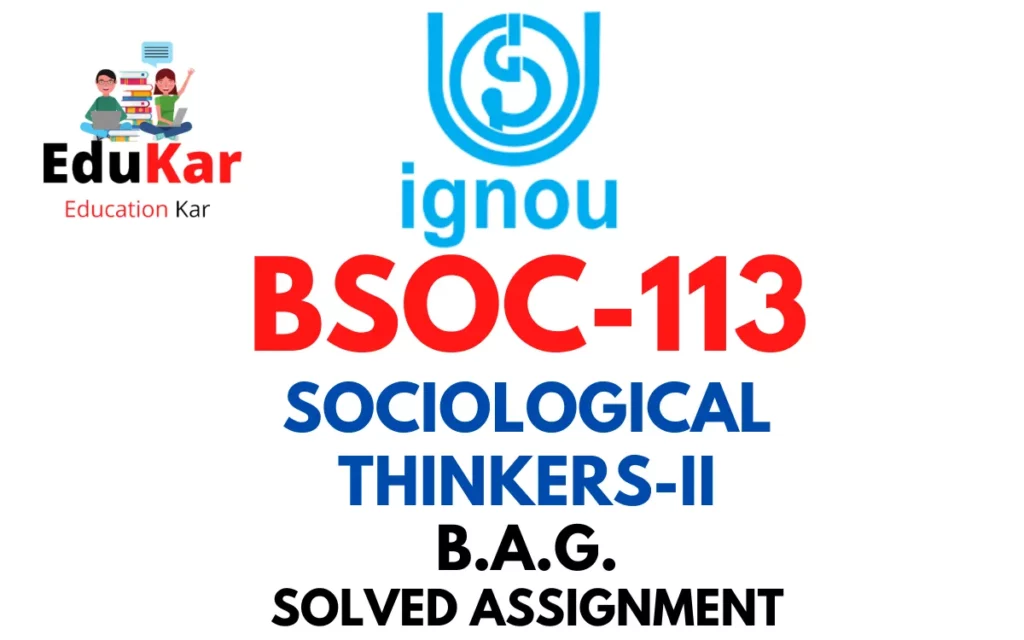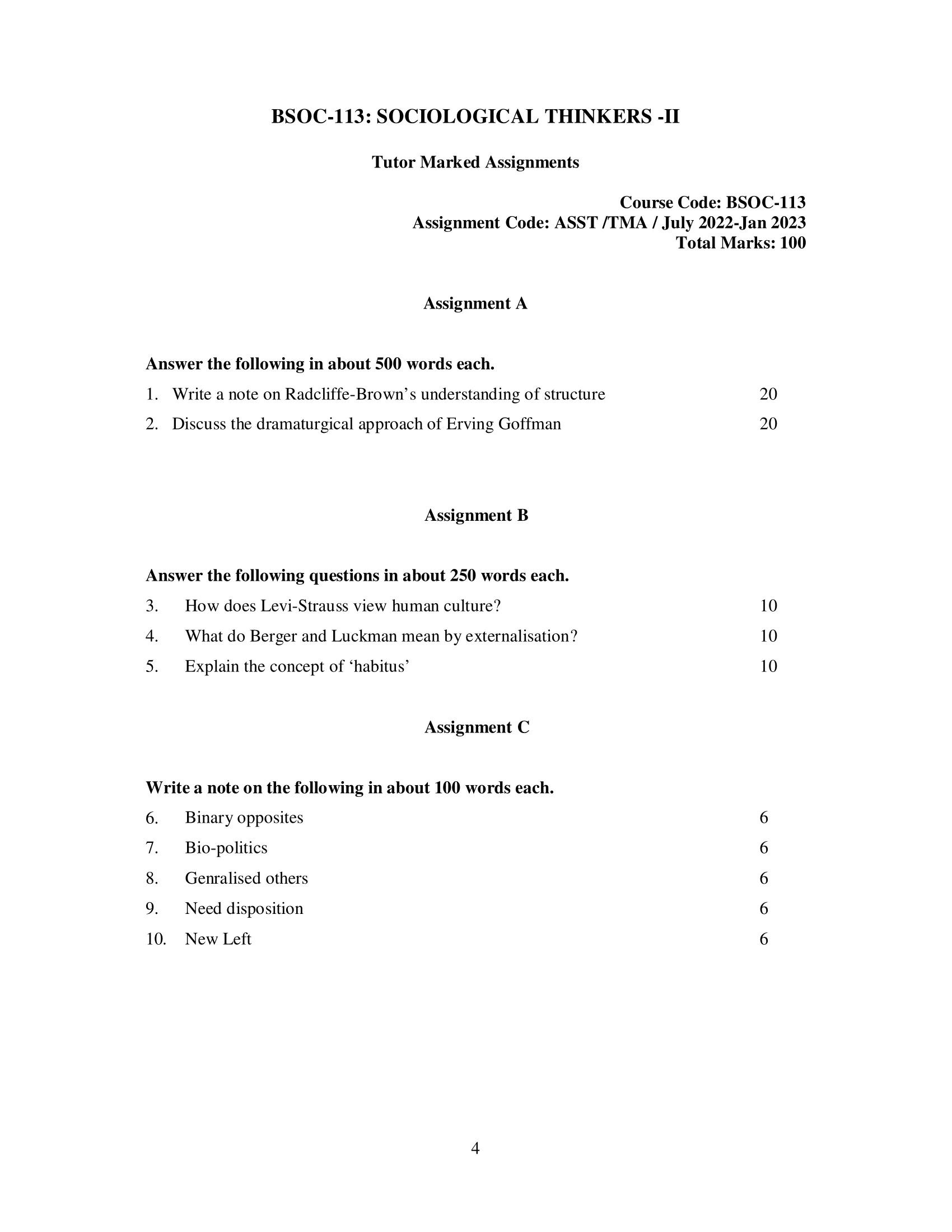Contents
- 1 Assignment A
- 2 Answer the following in about 500 words each.
- 3 1. Write a note on Radcliffe-Brown’s understanding of structure.
- 4 2. Discuss the dramaturgical approach of Erving Goffman.
- 5 Assignment B
- 6 Answer the following questions in about 250 words each
- 7 3. How does Levi-Strauss view human culture?
- 8 4. What do Berger and Luckman mean by externalisation?
- 9 5. Explain the concept of ‘habitus’.
- 10 Assignment C
- 11 Write a note on the following in about 100 words each.
- 12 6. Binary opposites.
- 13 7. Bio-politics.
- 14 8. Genralised others.
- 15 9. Need disposition.
- 16 10. New Left.

| Title | BSOC-113: IGNOU BAG Solved Assignment 2022-2023 |
| University | IGNOU |
| Degree | Bachelor Degree Programme |
| Course Code | BSOC-113 |
| Course Name | SOCIOLOGICAL THINKERS-II |
| Programme Name | Bachelor of Arts (General) |
| Programme Code | BAG |
| Total Marks | 100 |
| Year | 2022-2023 |
| Language | English |
| Assignment Code | ASST /TMA / July 2022-Jan 2023 |
| Assignment PDF | Click Here |
| Last Date for Submission of Assignment: | For June Examination: 31st April For December Examination: 30th September |

Assignment A
Answer the following in about 500 words each.
1. Write a note on Radcliffe-Brown’s understanding of structure.
Ans: A. Introduction: A.R. Radcliffe-Brown was an influential British social anthropologist who made significant contributions to the study of social structure. In his work, he emphasized the importance of social structure as an essential aspect of human society. According to Radcliffe-Brown, social structure refers to the patterns of relationships and social institutions that shape the behavior of individuals in a society. This note will explore Radcliffe-Brown’s understanding of social structure in more detail.
B. Radcliffe-Brown’s Understanding of Social Structure: Radcliffe-Brown’s approach to social structure focused on the ways in which social institutions and practices were organized and connected. He believed that social structures were not simply collections of individual actions but were instead systems of relationships and institutions that were interconnected and interdependent. In this way, social structure was seen as an overarching framework that shaped the behavior of individuals within a society.
One of the key concepts in Radcliffe-Brown’s understanding of social structure was that of functionalism. According to functionalism, social institutions and practices were functional in the sense that they served a specific purpose within a society. For example, the institution of marriage served to regulate sexual behavior and to create social bonds between individuals. Functionalism, therefore, emphasized the ways in which social institutions and practices contributed to the overall functioning of a society.
Radcliffe-Brown also emphasized the importance of social norms and rules in shaping social structure. He argued that social norms were the shared expectations and beliefs that governed the behavior of individuals within a society. These norms were not arbitrary but were instead shaped by the social and cultural context of a given society. Social rules, in turn, were the formal and informal regulations that enforced social norms and ensured their adherence. The combination of social norms and rules, therefore, helped to create and maintain the social structure of a society.
C. Critiques of Radcliffe-Brown’s Understanding of Social Structure: Despite the significant contributions that Radcliffe-Brown made to the study of social structure, his approach has also been subject to several critiques. One of the key critiques of functionalism is that it tends to view social institutions and practices as static and unchanging. This perspective overlooks the ways in which social structures are shaped by historical and cultural context and how they can change over time.
Another critique of Radcliffe-Brown’s approach is that it tends to overlook the agency of individuals in shaping social structure. While social norms and rules may shape behavior, individuals also have the ability to resist or modify those norms in their daily lives. As a result, social structure is not always a rigid or inflexible framework but can be subject to change through individual action and agency.
D. Conclusion: In conclusion, Radcliffe-Brown’s understanding of social structure emphasized the importance of social institutions, practices, and norms in shaping human behavior. His approach to functionalism provided a valuable framework for understanding how social structures contribute to the functioning of society. However, his approach also had its limitations, particularly in its tendency to view social structures as static and unchanging. Despite these critiques, Radcliffe-Brown’s work continues to be an important influence on the study of social structure in anthropology and other social sciences.
2. Discuss the dramaturgical approach of Erving Goffman.
Ans: Erving Goffman was a prominent sociologist who made significant contributions to the study of social interaction and communication. One of his most important contributions was the development of the dramaturgical approach, which drew on the metaphor of theater to understand social behavior. This note will discuss the key ideas and concepts associated with Goffman’s dramaturgical approach.
A. The Basic Concepts of the Dramaturgical Approach:
The dramaturgical approach is based on the metaphor of theater, in which social behavior is viewed as a series of performances. In this approach, individuals are seen as actors who are constantly performing for an audience. The audience may be actual people who are present during the performance, or it may be a more abstract idea of the social norms, values, and expectations that shape social behavior.
The dramaturgical approach is composed of several key concepts. The first of these is front stage and back stage behavior. Front stage behavior refers to the performances that individuals give when they are in the presence of an audience. This behavior is carefully managed and is intended to create a particular impression on the audience. In contrast, back stage behavior refers to the more informal, unscripted behavior that individuals engage in when they are not in the presence of an audience.
Another key concept is impression management. Impression management refers to the strategies that individuals use to create a particular impression on their audience. This might involve manipulating their appearance, their language, their behavior, or their setting to create a desired effect. For example, a politician might carefully craft their appearance and language to create a particular image for the public.
A third key concept is facework. Facework refers to the efforts that individuals make to maintain their own face or image in the eyes of others. This might involve saving face by avoiding embarrassment or loss of status, or it might involve attacking the face of another individual to gain an advantage.
B. The Applications of the Dramaturgical Approach:
The dramaturgical approach has been applied to a wide range of social phenomena. One example is the study of deviant behavior, where the dramaturgical approach has been used to understand how individuals engage in deviant behavior while still trying to maintain their public image. The approach has also been used to study organizational behavior, where it has been applied to understand how individuals within an organization engage in impression management and facework to advance their own interests.
The approach has also been used to study online behavior, where it has been applied to understand how individuals use social media to create a particular image for their audience. In this context, individuals may use a variety of techniques to create a desired image, such as carefully curating their online persona or strategically timing their posts to maximize their impact.
C. Critiques of the Dramaturgical Approach:
The dramaturgical approach has also been subject to several critiques. One critique is that the approach tends to overlook the role of structural factors in shaping social behavior. This perspective may overemphasize the role of individual agency and downplay the importance of broader social forces, such as economic inequality or political power dynamics.
Another critique is that the approach may overlook the emotional and affective dimensions of social interaction. While individuals may engage in impression management and facework to create a particular image, they may also experience a range of emotions and feelings during social interactions that are not accounted for in the dramaturgical approach.
Assignment B
Answer the following questions in about 250 words each
3. How does Levi-Strauss view human culture?
Ans: Claude Levi-Strauss, a French anthropologist, is known for his contributions to the structuralist approach to the study of culture. According to Levi-Strauss, human culture can be understood as a system of signs and symbols that is shared by members of a particular society. Here are some key ideas about human culture in Levi-Strauss’s view:
Firstly, Levi-Strauss viewed human culture as a universal phenomenon. He argued that all human societies share a common structure and that the differences between societies are a result of variations within this underlying structure. For Levi-Strauss, human culture is not just a product of historical and environmental factors, but is rather a manifestation of the deep structures of the human mind.
Secondly, Levi-Strauss saw human culture as a system of signs and symbols that is shared by members of a particular society. This system of signs and symbols is a form of communication that allows individuals to understand and interact with their environment. According to Levi-Strauss, these signs and symbols are not arbitrary, but are rather part of a larger system of meaning that is shared by members of a particular society.
Finally, Levi-Strauss argued that human culture is characterized by a process of binary oppositions. He suggested that human societies categorize their environment into pairs of opposites, such as nature/culture, male/female, or raw/cooked. These oppositions are not just simple dichotomies, but rather complex systems of meaning that are used to create social order and structure.
4. What do Berger and Luckman mean by externalisation?
Ans: In their book “The Social Construction of Reality,” Peter Berger and Thomas Luckmann describe how human beings create and maintain a shared reality that is external to individuals. One of the key concepts they use to explain this process is externalisation.
Externalisation refers to the process by which human beings create and objectify the world around them. In other words, externalisation is the process by which subjective experiences, thoughts, and feelings are transformed into tangible, external objects that exist independently of any individual’s consciousness. For example, when people build houses, cars, or bridges, they externalize their ideas and turn them into concrete, material objects that exist in the world.
Berger and Luckmann argue that externalisation is a fundamental process in the construction of reality, because it allows individuals to create a shared world that is not just a product of their individual experiences or subjective perspectives. Through externalisation, people are able to create a world that is external to them, and that can be experienced and understood by others.
According to Berger and Luckmann, externalisation is not just a process that happens in the physical world, but also in the social world. For example, language is a form of externalisation, because it allows individuals to objectify and communicate their thoughts and ideas to others. Institutions like religion, law, and politics are also forms of externalisation, because they are tangible, external objects that exist independently of any individual’s consciousness, but are shared by many people.
5. Explain the concept of ‘habitus’.
Ans: The concept of habitus was developed by French sociologist Pierre Bourdieu to explain how individuals develop particular dispositions and behaviors as a result of their socialization and the cultural norms and values they are exposed to. Habitus can be understood as a system of durable, internalized dispositions that shape an individual’s thoughts, beliefs, and actions in particular ways, and that are shaped by their social and cultural environment.
Habitus is not a fixed or predetermined set of behaviors or characteristics, but rather a flexible and adaptable set of dispositions that can be activated in different social contexts. It is the result of an individual’s socialization and their experiences in the world, and is shaped by the cultural, economic, and social resources available to them. For example, an individual from a working-class background may develop a habitus that values practical skills and hard work, while an individual from an upper-class background may develop a habitus that values education and cultural capital.
Habitus is a useful concept for understanding how social inequalities are reproduced across generations. Because habitus is shaped by an individual’s social and cultural environment, those who are born into privileged social positions are more likely to develop a habitus that aligns with the cultural norms and values of their social class. Conversely, those who are born into disadvantaged social positions may develop a habitus that is not valued or rewarded by dominant cultural institutions.
Habitus is not just an individual phenomenon, but also a social one. It is a product of the collective experiences and histories of a particular social group, and is shaped by broader cultural and social structures. Bourdieu argues that habitus is a key mechanism through which social structures and cultural norms are reproduced over time.
Assignment C
Write a note on the following in about 100 words each.
6. Binary opposites.
Ans: Binary opposites refer to pairs of opposing concepts or categories that are considered as fundamentally different from one another. These pairs of concepts are often used to create meaning in language and communication, and they are often seen as complementary and mutually exclusive. Examples of binary opposites include good vs. evil, light vs. dark, male vs. female, and us vs. them. While binary oppositions can help to simplify complex ideas and provide structure to language, they can also perpetuate stereotypes and oversimplify the nuances and complexities of the world.
In literature and cultural studies, binary opposites have been widely explored as a tool for understanding the power dynamics within society. By deconstructing binary oppositions, scholars can expose the ways in which these categories are socially constructed and reveal the underlying power structures that uphold them.
7. Bio-politics.
Ans: Biopolitics is a concept coined by French philosopher Michel Foucault to describe the ways in which power operates through the regulation and control of bodies and populations. Biopolitics encompasses a wide range of practices, including medicine, public health, and social policy, that aim to manage and regulate the health and welfare of individuals and populations.
At its core, biopolitics is concerned with the optimization of life, both at the individual and population level. This can involve practices such as vaccination, disease surveillance, and public health interventions that seek to prevent illness and prolong life. However, biopolitics can also be used to justify practices that limit or control individual freedoms, such as compulsory sterilization or quarantine measures.
Foucault argued that biopolitics is an extension of traditional forms of sovereignty and governance, in which the state exercises control over the bodies and lives of its citizens. However, biopolitics is distinct in that it operates on a more subtle and diffuse level, working through the normalization of certain behaviors and the creation of norms and standards that govern social life.
Critics of biopolitics argue that it can be used to justify oppressive practices and that it can perpetuate social inequalities. Others argue that biopolitics is an essential tool for promoting public health and welfare, and that it can be used to empower individuals and communities.
8. Genralised others.
Ans: The concept of “generalized others” was first introduced by American sociologist George Herbert Mead to explain how individuals develop a sense of self in relation to others in their social environment. Mead argued that the self is not an innate or fixed characteristic, but rather a dynamic and evolving process that emerges through social interaction.
According to Mead, the “generalized other” refers to the collective attitudes, values, and expectations of the community or society in which an individual lives. These shared beliefs and norms provide a framework for how individuals see themselves and others, and they help to shape an individual’s sense of identity and selfhood.
The generalized other is a key aspect of Mead’s theory of symbolic interactionism, which emphasizes the importance of language and communication in shaping social reality. Through interactions with others, individuals come to understand and internalize the shared meanings and values of their social environment, which in turn shapes their actions and behaviors.
The concept of the generalized other has been influential in a wide range of fields, including sociology, psychology, and communication studies. It has been used to explain how individuals learn and adopt cultural norms and values, as well as how social groups and communities develop collective identities and shared understandings.
9. Need disposition.
Ans: The term “disposition” refers to a person’s general tendency or inclination to think, feel, and behave in certain ways. It encompasses a wide range of personality traits, such as openness, conscientiousness, extroversion, agreeableness, and neuroticism, which have been identified by personality psychologists as important factors in determining a person’s behavior and attitudes.
Dispositions are thought to be relatively stable over time and to have a genetic component, although they can also be influenced by environmental factors such as upbringing, education, and life experiences. They can be positive or negative, and they can have both advantages and disadvantages depending on the situation.
For example, someone with a disposition toward conscientiousness might be highly organized and responsible, but they might also be prone to perfectionism and rigidity. Someone with a disposition toward openness might be creative and imaginative, but they might also be more prone to anxiety and existential questioning.
The study of dispositions is important in a wide range of fields, including psychology, sociology, and education, as it helps to explain why individuals differ in their thoughts, feelings, and behaviors. It also provides a framework for understanding how dispositions can be influenced and changed, and how they can be used to promote positive outcomes in personal and social contexts.
10. New Left.
Ans: The New Left is a political movement that emerged in the 1960s in response to what its adherents saw as the failures of traditional left-wing politics. The New Left rejected the authoritarianism and bureaucratic organization of traditional socialist and communist parties, and instead emphasized a decentralized, participatory form of democracy.
The New Left was characterized by its focus on civil rights, anti-war activism, and environmentalism, as well as its opposition to what it saw as the homogenizing effects of consumer culture and mass media. It also emphasized the importance of cultural and identity-based struggles, particularly in relation to issues of gender, sexuality, and race.
The New Left was closely associated with the student protest movements of the 1960s, particularly in the United States and Europe, and was often associated with countercultural movements such as the hippie and anti-establishment movements. It was also influential in the development of new social movements such as feminism, environmentalism, and anti-racism.
The legacy of the New Left can be seen in the continued emphasis on social justice and democratic participation in contemporary progressive politics. It also played a role in the development of the academic field of cultural studies, which explores the intersection of culture, politics, and society. While the New Left was often criticized for its lack of clear political goals and strategies, its emphasis on participatory democracy and social justice has continued to shape contemporary political discourse.
How to Download BSOC-113 Solved Assignment?
You can download it from the www.edukar.in, they have a big database for all the IGNOU solved assignments.
Is the BSOC-113 Solved Assignment Free?
Yes this is absolutely free to download the solved assignment from www.edukar.in
What is the last submission date for BSOC-113 Solved Assignment?
For June Examination: 31st April, For December Examination: 30th October
















